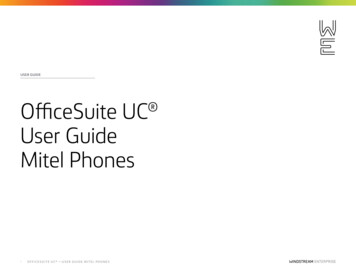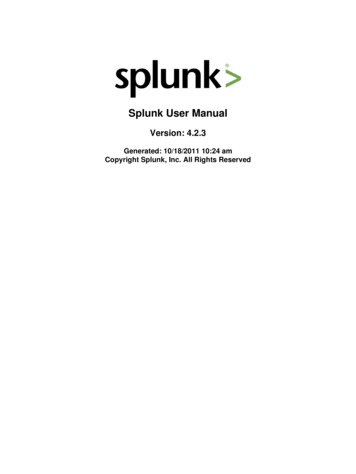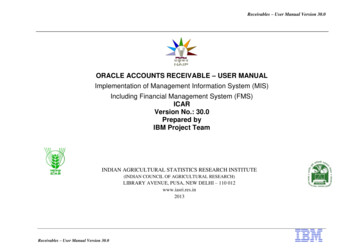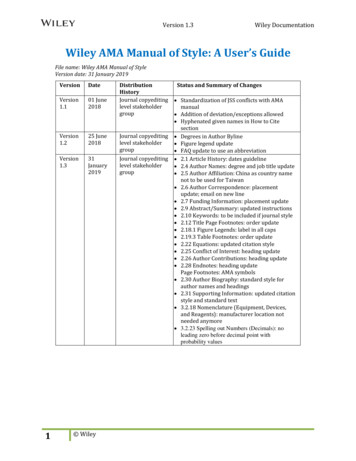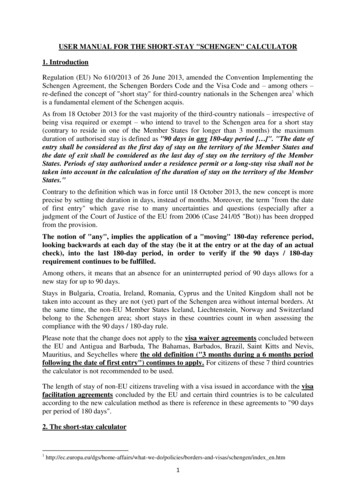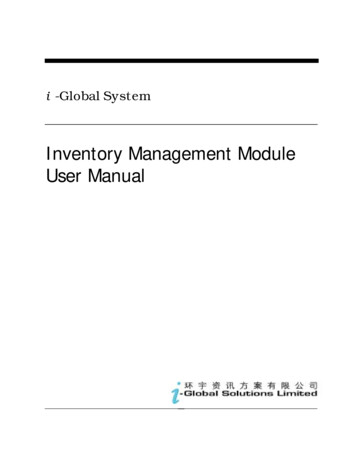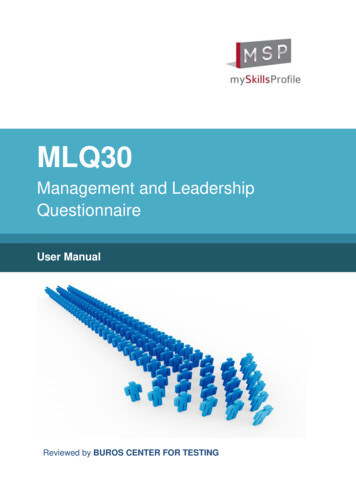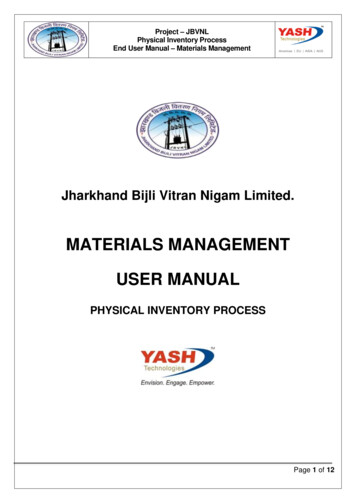
Transcription
USER MANUALwww.orbea.com
INTRODUCTIONThis user manual contains information needed toride your Orbea bicycle safely and get the mostout of it. The failure to follow the instructionsor warnings contained in this manual is theresponsibility of the rider or the correspondingguardian, in the case of a minor.In any case, safety also depends on factors that gobeyond the bicycle, which are not covered in thisuser manual. E.g.: The skill of the user, knowingand obeying traffic regulations, the conditionsof the route, personal conditions, etc. all have aninfluence. Controlling these factors reduces thedanger, but you must be aware that the likelihoodof falling or suffering other types of injuries cannotbe completely eliminated. In other words, the riskof an accident is part of the sport of cycling. Alwaysobey the traffic regulations in force, and alwayswear a helmet and protective glasses when ridinga bicycle.For more information aimed at getting the mostout of each model of ORBEA bicycle, visit the websupport section at http://www.orbea.com/es-es/soporte/and our YouTube channel https://www.youtube.com/user/OrbeaBicycles.We recommend visiting an ORBEA dealer if you donot clearly understand anything in this manual orif you lack the proper tools. At http://www.orbea.com/es-es/distribuidores you will find the ORBEAdealer nearest you.For issues related to purchases made on ourwebsite,www.orbea.com, please call 902 04 29 29 (availableMonday-Friday).For any other question not answered throughthe channels mentioned above, please contact usdirectly.Orbea S.Coop.Poligono I. Goitondo 48269 MallabiaPhone: 34 943171950e-mail: Orbea@orbea.comThis manual meets the requirements of standardsEN 14764, 14766 and 14781 and its contentsare the property of Orbea S.Coop. Its partial ortotal reproduction is prohibited without expressauthorization.SYMBOLSPay attention when you see the following symbolsin this manual.They are used for additional non-safetyrelated information that might beuseful.Indicates required measures to preventa potential hazard that could result inproperty damage.Indicates actions that must be taken toprevent a potential hazard that couldjeopardize the physical wellbeing andeven the life of the rider, in addition toproperty damage.2
CONTENTSINTRODUCTION 2SYMBOLS 2CONTENTS 3EXPLODED VIEW 4ROAD (Rim Brake) 4ROAD (Disc Brake) 5MTB 6ALL-USE 7TRI 8TERMS OF USE 9SERVICE LIFE 10BEFORE FIRST USE 11SIZE CHECK 11SEAT ADJUSTMENT 11HANDLEBAR ADJUSTMENT 12BRAKE LEVER ADJUSTMENT 15SUSPENSION ADJUSTMENTS 15ADAPTATION 16SAFETY CHECKS 17WHEELS 17BRAKES 18SEAT 21HANDLEBAR AND STEM 21HEADSET 22FRONT SUSPENSION 23REAR SUSPENSION 23PEDALS 24SAFETY EQUIPMENT 26MAINTENANCE 27CLEANING 27LUBRICATION 27STORING THE BICYCLE FOR A PROLONGED PERIOD OF TIME 29WARRANTY 30DECLARATION OF CONFORMITY 32SUPPLEMENTARY NOTES 34ADDITIONAL INFORMATION 363
EXPLODED VIEWROAD (Rim Brake)The diagram below shows the position of each of the components of an ORBEA road bike with caliper orrim brakes. Even though the bicycle model shown in the diagram may not exactly match the bicycle youpurchased, the main components indicated are the same for . Frame2. Fork3. Stem4. Handlebar5. Brake lever6. Gear change7. Tire8. Rim9. Spoke10. Hub11. Skewer12. Pedal13. Cranks14. Chain15. Front Derailleur16. Rear Derailleur17. Cogs18. Brakes19. Seatpost20. Saddle21. Seat latch22. Head tube4
ROAD (Disc Brake)The diagram below shows the position of each of the components of an ORBEA road bike with disc brakes.Even though the bicycle model shown in the diagram may not exactly match the bicycle you purchased,the main components indicated are the same for . Frame2. Fork3. Stem4. Handlebar5. Brake lever6. Gear change7. Tire8. Rim9. Spoke10. Hub11. Wheel latch12. Pedal13. Cranks14. Chain15. Front Derailleur16. Rear Derailleur17. Cogs18. Brakes19. Seatpost20. Saddle21. Seat latch22. Head tube5
MTBThe diagram below shows the position of each of the components of an ORBEA mountain bike. Eventhough the bicycle model shown in the diagram may not exactly match the bicycle you purchased, themain components indicated are the same for 61. Frame2. Fork3. Stem4. Handlebar5. Brake lever6. Gear change7. Tire8. Rim9. Spoke10. Hub11. Skewer12. Pedal13. Cranks14. Chain15. Front Derailleur16. Rear Derailleur17. Cogs18. Brakes19. Seatpost20. Saddle21. Seat latch22. Head tube23. Rearsuspension6
ALL-USEThe diagram below shows the position of each of the components of an ORBEA general use bike. Eventhough the bicycle model shown in the diagram may not exactly match the bicycle you purchased, themain components indicated are the same for . Frame2. Fork3. Stem4. Handlebar5. Brake lever6. Gear change7. Tire8. Rim9. Spoke10. Hub11. Skewer12. Pedal13. Cranks14. Chain15. Front Derailleur16. Rear Derailleur17. Cogs18. Brakes19. Seatpost20. Saddle21. Seat latch22. Head tube7
TRIThe diagram below shows the position of each of the components of an ORBEA triathlon bike. Eventhough the bicycle model shown in the diagram may not exactly match the bicycle you purchased, themain components indicated are the same for . Frame2. Fork3. Stem4. Handlebar5. Brake lever6. Gear change7. Tire8. Rim9. Spoke10. Hub11. Skewer12. Pedal13. Cranks14. Chain15. Front Derailleur16. Rear Derailleur17. Cogs18. Brakes19. Seatpost20. Saddle21. Seat latch22. Head tube8
TERMS OF USEEach model of bicycle is designed andmanufactured for a specific use. Using a bicycle fora use other than the one it was designed for can bedangerous for several reasons.Contact an ORBEA dealer to identify or confirm themodel of bicycle appropriate for a specific use.The standard F-2043-13 from ASTM Internationalspecifies five levels of terms of use. Below are thecharacteristics of each level and the correlationwith each ORBEA family.CONDITION 33Riding on irregular and roughterrain, with jumps of less than61cm (condition 3 of ASTMstandard F-2043-13, in additionto the conditions indicated inconditions 1 and 2).Not designed for use withluggage carriers, child seats or trailers.Maximum cyclist weight: 115 kgORBEA bicycle models: Mx and Sport.CONDITION 1Riding limited to paved roadswith tires in constant contactwith the road surface. (condition1 of ASTM standard F-2043-13).1trailers.Not designed for use withluggage carriers, child seats orMaximum cyclist weight: 115 kgORBEA bicycle models: Orca, Avant and Ordu.trailers.4Riding on technically difficultterrain, with jumps andextremelyroughterrain(condition 4 of ASTM standardF-2043-13, in addition to theconditionsindicatedinconditions 1, 2 and 3).Not designed for use with luggage carriers, childseats or trailers.Maximum cyclist weight: 115 kgORBEA bicycle models: Alma, Oiz, Loki andOccamTR.CONDITION 22CONDITION 4Riding on paved or gravel roadsor on unasphalted trails in goodcondition, as well as bike lanes(condition 2 of ASTM standardF-2043-13, in addition to theconditionsindicatedincondition 1).Not designed for use withluggage carriers, child seats orMaximum cyclist weight: 115 kgORBEA bicycle models: Katu, Carpe, Urban, Foldingand Comfort.CONDITION 5Riding on extreme terrain athigh speed; extreme caution isrecommended (This bicycle isno excuse to try just anything!).5trailers.Not designed for use withluggage carriers, child seats orMaximum cyclist weight: 115 kgORBEA bicycle models: Rallon and OccamAM.9
The failure to use the bicycle under these specifiedterms of use would represent restrictions in thewarranty.Regardless of the terms of use corresponding toeach type of bicycle, it is recommended to alwaysobey current traffic laws, wear a helmet andprotective goggles and check the brakes, wheelsand steering, etc., beforehand, as indicated in theChapter “Safety Checks”.With regard to children’s bicycles, theterms of use require the supervision of an adultwho accompanies the child at all times, preventingthem from riding near slopes, curbs, stairs,swimming pools or areas with motor vehicle traffic.If the bicycle is made from compositematerials (carbon) it cannot be exposed totemperatures above 50 ºC, either in use or whileat rest.SERVICE LIFELike all mechanical components, the bicycle issubject to wear and mechanical stress that limitsits service life. The service life will depend on thedesign, material and manufacturing, as well asthe conditions of use, such as the cyclist’s weight,the frequency of use, the aggressiveness ofriding, cleaning and maintenance, environmentalconditions, etc. and so its limit cannot be calculatedprior to use. Therefore, and given that exceedingthe service life of the bicycle could result in anaccident that causes injury to the cyclist, it isrecommended to periodically inspect your bicycleand consult an ORBEA dealer whenever you haveany doubts in this regard. Excessive bending,anomalous operation, cracks or change in colorin high mechanical stress areas may be symptomsthat the bicycle or a specific component havereached the end of their service life and must bereplaced.10
BEFORE FIRST USEIt is extremely important to perform thefollowing checks and adjustments and go througha process of adaption before using the bicycle forthe first time. The following guidelines also applyto those cases in which you intend to use a bikewith an unknown condition.Before the first use, in addition to the followinginstructions, perform all the checks indicated in thechapter “Safety checks”.Ergonomic adjustments affect the control,comfort and performance of the cyclist-bicyclesystem. Its correct adjustment can vary the factorssignificantly, increasing or reducing the safety andenjoyment to a large extent.The following adjustment instructions consist ofa series of basic notions that aim to cover all theminimal requirements in this regard. For moreinformation in this regard, please consult an ORBEAdealer or a biomechanical specialist.If you wish to get the best performancefrom your bicycle fit, we recommend having acomplete fitting with experts.SEAT ADJUSTMENTThe seat adjustment is the most important in termsof performance and comfort.Seat height: To adjust the height of the seat, use aperson or a roller to hold the bicycle while the ridermounts it. Once mounted and seated on the seat,rest your heels on the pedals and pedal backwards.The recommended seat height is that required tocompletely extend the knee to reach the pedal atits lowest point. If you need to balance with yourhips to reach the pedal at its lowest point, then theseat is too high.When performing the adjustments, thereis a specific risk of entrapment.SIZE CHECKHaving a bicycle that matches the measurementsof each cyclist is essential for obtaining thegreatest comfort, performance and safety whenriding a bicycle. For this reason, the po/recommends the most appropriate size in terms ofthe measurements of each cyclist, according to thebasic data on the cyclist.If when pedaling with great intensity, younotice an improvement when sliding back on theseat, it is likely that the seat is too low. If, on theother hand, the need is detected to move towardsthe tip of the seat to pedal, it is likely that the seatis too high.11
To release and lock the seat, use the quick latch(instructions can be found in “Safety checks /Wheels”), or otherwise, use the correspondingscrews), applying the recommended tighteningtorque.This adjustment is used to positionyourself correctly on the bike and ensure acomfortable, efficient pedaling. For this reason,it is recommended to visit an ORBEA dealer for aprecise adjustment.HANDLEBAR ADJUSTMENTThe height of the handlebar and its angle areadjustable for greater comfort, efficiency andbetter balance of the rider on the bicycle.When raising the seat post from theminimum level, it should always remain hiddenwithin the frame.If it were necessary to raise the seat post beyondthe minimum insertion mark, it would b necessaryto review the size of the frame or replace the seatpost with a longer model, under the supervision ofan ORBEA dealer.Seat angle: To adjust the seat angle, adjust thetightening mechanism located on the top of theseat post. Consult the user’s manual from the seatprovider and follow the instructions to adjust it.To change both the height and the angle of thehandlebar, adjust the stem.There are two types of stems:- Traditional stem: has a tube that is attached insidethe fork by means of a cone and a stem tighteningbolt.- Ahead stem: attached to the outside of the headtube.It is also possible to replace the stem and handlebarwith components with different geometries thathelp adapt the bicycle to the cyclist.A seat that is not adjusted horizontally(parallel to the ground) causes the rider to have avery unrelaxed pedaling position. The seat shouldnever be tilted backwards.Moving the seat forward/backwards: To adjust theforward/backward position of the seat, adjust thetightening mechanism located on the top of theseat post. Consult the user’s manual from the seatprovider and follow the instructions to adjust it.12
Height of the handlebar on the traditional stem:Tornillo deapriete de lapotenciaTornillo deapriete delmanillarConoMarca deinserciónmínimaLoosen the tightening bolt, turning it twice in acounterclockwise direction.Do not overtighten the bolt; it could breakand seriously jeopardize your safety.To make sure that the entire assembly has beencompleted correctly, please see the chapter “Safetychecks”.Angle of the handlebar on the traditional stem:Loosen the tightening bolt on the handlebarlocated on the stem until the handlebars can beturned.Position th
Maximum cyclist weight: 115 kg ORBEA bicycle models: Katu, Carpe, Urban, Folding and Comfort. CONDITION 3 3 Riding on irregular and rough terrain, with jumps of less than 61cm (condition 3 of ASTM standard F-2043-13, in addition to the conditions indicated in conditions 1 and 2). Not designe


